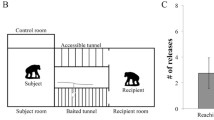Abstract
Juvenile and adolescent male chimpanzees sometimes threaten older, apparently stronger individuals such as mature females. I label the behavior harassment. Harassment comprises 25 behaviors, 14 of which are accompanied by the use of objects such as branches: Clubbing, flailing and throwing are the most common. Females respond to harassment with 10 behaviors, including scream, avoid, ignore, and retaliate. Females tend to respond to harassment by juvenile males by ignoring them. However, they are more likely to retaliate, scream or avoid in response to harassment by adolescent males. I propose the rank improvement hypothesis that harassment initiates the process of male domination of females, and compare the predictions derived from it with those of the exploratory aggression hypothesis. Males stopped harassing females significantly earlier when females ignored them versus when they did not ignore them. This is not consistent with the exploratory aggression hypothesis. Males harassed adult females significantly longer when females retaliated than when they did not, which is consistent with the rank improvement hypothesis. Although the observations are congruent with my hypothesis, we need more data to test it.
Similar content being viewed by others
References
Adang, O. M. J. (1984). Teasing in young chimpanzees. Behaviour 88: 98-122.
Adang, O. M. J. (1985). Exploratory aggression in chimpanzees. Behaviour 95: 138-163.
Adang, O. M. J. (1986). Exploring the social environment: A developmental study of teasing in chimpanzees. Ethology 73: 136-160.
Boesch, C., and Boesch-Achermann, H. (2000). The Chimpanzees of the Tai Forest, Oxford University Press, Oxford.
Goodall, J. (1986). The Chimpanzees of Gombe, Harvard University Press, Cambridge, MA.
Hebb, D. O. (1945). The forms and conditions of chimpanzee anger. Bull. Can. Psychol. Assoc. 5: 32-35.
Kummer, H., and Goodall, J. (1985). Conditions of innovative behaviour in primates. Phil. Trans. R. Soc. Lond. B 308: 203-214.
Maslow, A. H. (1940). Dominance-quality and social behavior in infra-human primates. J. Social Psychol. 11: 313-324.
Maynard Smith, J. (1982). Evolution and the Theory of Games, Cambridge University Press, Cambridge.
Nishida, T. (Ed.)(1990). The Chimpanzees of the Mahale Mountains. The University of Tokyo Press, Tokyo.
Nishida, T., Kano, T., Goodall, J., McGrew, W.C., and Nakamura, M. (1999). Ethogram and ethnography of Mahale chimpanzees. Anthropol. Sci. 107: 141-188.
Nishida, T. (2003). Individuality and flexibility of cultural behavior patterns in chimpanzees. In de Waal, F. B. M., and Tyack, P. L. (Eds.), Animal Social Complexity, Harvard University Press, Cambridge, MA, pp. 392-413.
Pusey, A. E. (1990). Behavioural changes at adolescence in chimpanzees. Behaviour 115: 203-246.
de Waal, F. B. M. (1982). The Chimpanzee Politics. Jonathan Cape, London.
de Waal, F. B. M., and Hoekstra, J. A. (1980). Contexts and predictability of aggression in chimpanzees. Anim. Behav. 28: 929-937.
Author information
Authors and Affiliations
Rights and permissions
About this article
Cite this article
Nishida, T. Harassment of Mature Female Chimpanzees by Young Males in the Mahale Mountains. International Journal of Primatology 24, 503–514 (2003). https://doi.org/10.1023/A:1023870229247
Issue Date:
DOI: https://doi.org/10.1023/A:1023870229247




